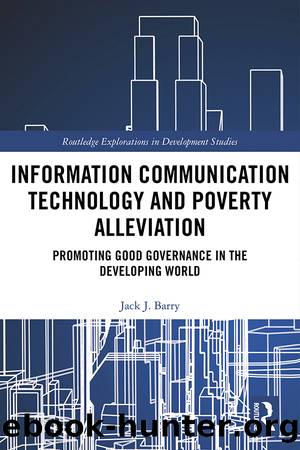Information Communication Technology and Poverty Alleviation by Jack J. Barry

Author:Jack J. Barry [Barry, Jack J.]
Language: eng
Format: epub
Tags: Social Science, Developing & Emerging Countries
ISBN: 9780429996191
Google: OFJmDwAAQBAJ
Publisher: Routledge
Published: 2018-07-24T04:45:08+00:00
4 Case study Mexico
Technological bubbles and black holes
Why Mexico? The comparative method and case study justification
The birdâs eye view of the global landscape presented in the first three chapters was a useful place to begin my analysis, but it became obvious that a more indepth study, at the regional, state, municipality, and individual level would add needed depth. The argument in Chapter 3 purported that Mexico is a useful developing state to investigate the impact of ICT on povertyâhowever, it displayed that a deeper exploration of the technological differences and poverty rates at the state level and municipality level would certainly help to construct the case that government has a strong influence on the quality, and quantity, of ICT access.
This chapter is vital because national level statistics have limitations and supplementing them with case study analysis is needed to get at causality. There is no doubt that varied local state and municipal environments can greatly impact the lives of the poorâelements that are simply not captured using national level data. To flesh out my argument, this chapter will begin with an explanation of why Mexico is an appropriate country for this analysis and my rationale for employing a comparative method. Second, the chapter will investigate the historical background of Mexico before analyzing structural evidence in data from Mexican states. Then I will explore data from Mexicoâs Silicon Valley, Guadalajara, and compare it to other major urban areas. Finally, analysis will turn to the rural state of Oaxaca and indigenous peopleâs use of ICT. The analysis finds that areas with âtechnological bubblesââareas of high ICT accessâtend to have better outcomes for poverty reduction than âtechnological black holesââareas of low ICT access.
Before introducing my case study, I will explain my use of the comparative method as well as my focus on Mexico. One of the strengths of the comparative method is that it is essentially a âway to control,â allowing researchers to explore many variables while maintaining a high degree of precision in analysis. Comparative politics has fully evolved into an approach to understanding political phenomena across polities rather than simply a methodology (e.g., Lijphart 1971; Sartori 1970). There are various ways to use the comparative approach. One is when there is variance in the independent variable, another is the âmethod of agreementâ (Mill 1974: 392), where all cases agree on the dependent variable, which acts as a âmethod of exclusionâ to rule out other possible causal factors. The opposite of this is also useful which is called âthe most different approachâ (Przeworski and Teune 1970), where cases have similar independent variables but differ on the outcome of the dependent variable. There are also the deviant and most similar case approaches, as defined by Seawright and Gerring (2008), which are useful concepts to explain cases that follow the typical pattern a researcher predicts from cases (i.e., similar case) and when they deviate from the norm (i.e., deviant case). The following section grapples with how the case of Mexico and ICTs fits into the comparative approach.
Download
This site does not store any files on its server. We only index and link to content provided by other sites. Please contact the content providers to delete copyright contents if any and email us, we'll remove relevant links or contents immediately.
Web Development with Julia and Genie by Ivo Balbaert & Adrian Salceanu(7000)
State Management with React Query by Daniel Afonso(3890)
Eleventy by Example by Robinson Bryan;(3789)
Architecting Vue.js 3 Enterprise-Ready Web Applications by Solomon Eseme(3583)
Building Python Web APIs with FastAPI by Abdulazeez Abdulazeez Adeshina(3422)
Digital Marketing with Drupal by José Fernandes(2888)
State Management with React Query by Afonso Daniel;(1520)
Building Data Science Applications with FastAPI by François Voron(1413)
Becoming an Enterprise Django Developer by Michael Dinder(1300)
Building Python Web APIs with FastAPI: A fast-paced guide to building high-performance, robust web APIs with very little boilerplate code by Abdulazeez Abdulazeez Adeshina(1232)
Operator Training Simulator Handbook by Joseph Philip(1215)
Hands-on Cloud Analytics with Microsoft Azure Stack: Transform Your Data to Derive Powerful Insights Using Microsoft Azure by Prashila Naik(1131)
Practical WebAssembly: Explore the fundamentals of WebAssembly programming using Rust by Sendil Kumar Nellaiyapen(1131)
Google Workspace User Guide: A Practical Guide to Using Google Workspace Apps Efficiently While Integrating Them With Your Data by Balaji Iyer(1109)
Building SPAs with Django and HTML Over the Wire: Learn to build real-time single page applications with Python by Andros Fenollosa(1070)
Modern Frontend Development with Node.js by Florian Rappl(992)
High Performance with Laravel Octane by R. Butti(973)
Kubernetes Design Patterns and Extensions by Onur Yilmaz(961)
JavaScript from Frontend to Backend by Unknown(877)
